Since most of the things I build are modular, and often get disassembled to use parts in other projects, I decided to make an exception for my ZVS Tesla Coil and leave it in a form easy to plug and play.
I already had the ZVS module, a good flyback transformer with built in HV diode, and lots of HV cables. Time to put everything together in a final form.
Here is a light bulb “powered” by my Tesla coil.
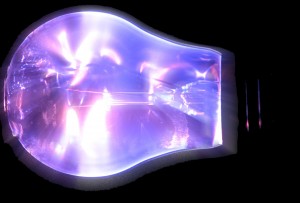
To my previous design I’ve added a second deck, to contain the power source (ZVS+flyback), the capacitor bank and the spark gap.
The tesla transformer has a secondary of 1500 windings (Cu 0.2 mm on a PVC pipe diameter 5cm/length 30cm), and a primary with 16 windings (Cu 4mm on PVC pipe diameter 11 cm/ length 10cm):
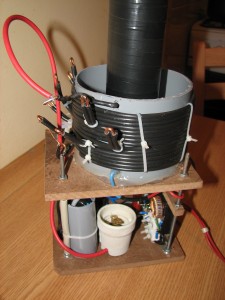
The primary has several plugs, used to make the primary and the secondary resonant at the same frequency.
Photo 1:The small PVC pipe contains the capacitor bank (9x10nF/6KV, connected for 10nF/18KV), and a small filter.
I’ve used a ceramic bulb socket to contain a static spark gap and limit the noise. It also has a lid, not shown in the photo
To the right you can see the ZVS module.
Photo 2: the ZVS Heatsink, and the power-in/ground connector. It might be a bad idea to have the ground so close to the low voltage connector. I’ll need to check that.
Photo 3: the flyback transformer, and the rewound primary (blue wire 4+4 windings). When powered by the ZVS driver at 30V the sparks start at 1.5cm and can be stretched to almost 4cm. Quite powerful.
Photo 4: front view, the flyback , a small filter connected on the ‘cold’ wire (black) and the capacitor bank again.
This setup needs further improvements, so I’ll update this post soon.


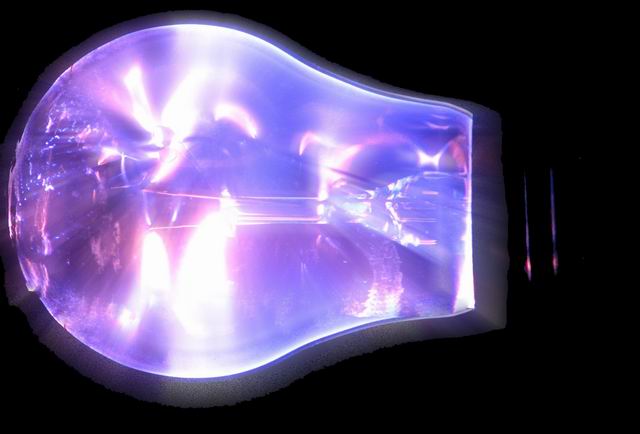
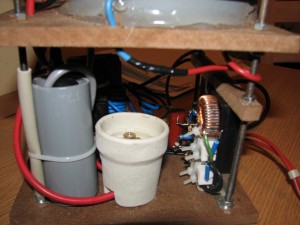
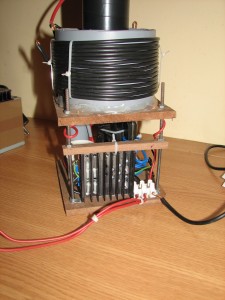
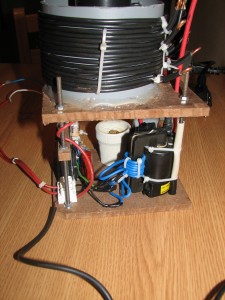
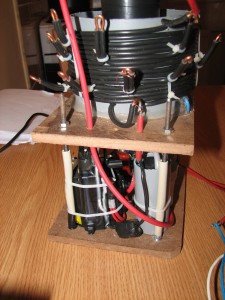
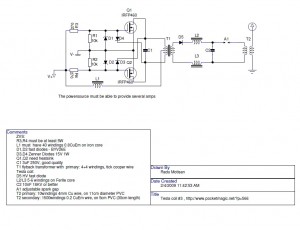
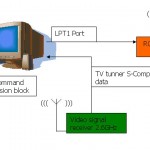
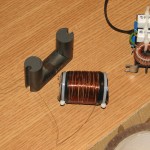
Vad ca in schema L1 este tor din fier? sau pot folosi tot din ferita?
La partea ZVS, L1 e din pulbere de fier
Unde ai conectat firul de impamantare de la bobina secundara (cea de 1500 spire),unu merge la torul de alumniniu de deasupra dar celalalt unde sa l conectez?
poti sa-l conectezi la calorifer, la teava de apa
The left side of the circuit with your flyback as the output is a SOLID STATE Tesla Coil (the flyback with ferrite core aside and all not being a true TC), and the right side of the circuit is a SPARK GAP Tesla Coil. You already have a ZVS timed/resonant circuit for your sold state TC side, so why add a spark gap TC on its output? Normally the input power supply for a spark gap TC should be steady supply, not a TC itself. I’m confused about why you did this? 🙂
Hi Joe, thanks for your comment.
The ZVS itself should be seen as a separated HV supply only, since I don’t have a neon sign transformer I had to improvise.
Salut Radu. In secundarul bobinei Tesla ai bobinat doar un singur strat (1500 spire)?
Daca bobinezi mai multe straturi , de ex 4 straturi de 1500 spire, ce efect ar avea bobiba Tesla? I-ar creste tensiunea in secundar?
Multumesc.
salut Cristian
Am bobinat un singur strat doar. Nu e o idee buna sa bobinezi mai multe straturi, vei avea pierderi, si arc intre straturi.
Pentru a vedea cum sa cresti tensiunea, arunca un ochi aici:
http://www.elforum.ro/viewtopic.php?f=14&t=35053
hi. Radu Motisan, I know u used fly back to generate high voltage for TC, but my question is why don’t u simply connect the ZVS circuit directly to the primary of the TC so it will become a DRSSTC? why go for inefficient noisy SGTC?
I mean i want to know the reason why don’t people use ZVS directly to power a TC? Why?
Because my ZVS driver was using only 30V max input, resulting in low output voltages so I used the flyback and a high voltage capacitor for higher voltage.
It is possible to use a Royer oscillator to power an air transformer (tesla coil) if you go for higher input voltages, see: http://webspace.webring.com/people/it/teslina/oltcp.html
Thanks for reply.
Dear Radu Motisan, I have built ZVS circuit and also driven several TV flybacks and burnt many of them too, bc i operated them at 40 volts DC, even when immersed in oil. The cause of failure was mainly the internal insulation breakdown.. I got about 7inch arcs with those flybacks.
But i have read some where (and experienced it my self too), that whatever the DC voltage we apply to the ZVS, the sine wave that ZVS generates as its output at the primry side of flyback, is several times greater than the DC we apply as an iput. like i read some where that the peak voltage of the primary sin wave reaches to about 5 times of the DC input to applied ZVD, i have also read somewhere that the output of ZVS is 2*pi times the input DC voltage. In my practical case, i haven’t calculated exact voltage boost, but rise in the voltage is a fact and it happens(Due to RLC series resonance effect in ZVS).
Now after some history, back to the point, i want to ask u, why people make complex full bridge circuits and half-bridge circuits do drive TC. I think the most simplest, efficient and robust method would be to use ZVS as the power source for the primary of the Tesla Coil. In your case, your point is valid, as u used/had only 30V DC. But if we operate the same ZVS at 150V or say 200V, and due to inherent amplification of ZVS, the voltage at the primary of TC will rise to 500+volts. this will produce very good streamers. But why people don’t use it, i have searched the net, only found v.very few people(2 or 3 at most) who have done it. And their arcs are too small, i.e., 1 to 2 inches only
I have made a Tesla coil out of a 3.5inch dia and 2feet length PVC pipe. I wound about 1100 turns of 30awg wire, and as a primary, i used 2.5 turns of copper tubing. the power source was 30V DC, 20AMP max current handling capability.
I drove my TC with ZVS and it produces streamers limited to only 3 to 4iches(but they sound to furious). i only used 30 volts. What would happen if i used 220V DC as input? (also i spent very little time in tuning, so it is not tuned properly.)
so in short, what i want to know is that, is there any problem in driving TC with ZVS and getting streamers of like 2feet in length(for say 2feet long TC, like in conventional DRSSTC?). If there is an issue plz tell me, so that i should not waste my time using ZVS as power source to TC.
Sorry For ur precious time
sorry i wrote “ZVD” accidentally instead of “ZVS”
Hi Sun, thanks for the feedback.
Actually a direct coupled ZVS -> TC driver exists, have you seen the link I gave you?
http://webspace.webring.com/people/it/teslina/oltcp.html
Made by a good friend, vasil .
Thanks dude. I have seen the url u sent, I have seen those pictures of streamers on the main page of the URL that u set, but i can not see the schematic diagram on URL: http://webspace.webring.com/people/it/teslina/oltcsch.html, labeled as “ELECTRIC SCHEMA, COMPONENTS, SPECS”. If i were able to see those pictures, i would have known that it is ZVS circuit. I will try to see those pictures on my university internet tomorrow.
Thanks again for ur cooperation
Hi Radu Motisan,
Plz see the link of a picture below, do u think it is possible with tesla coil,i.e., tuned at the frequency in which the top load is a human body, instead of a normal toroidal load?
http://www.pocketmagic.net/?p=566&cpage=1#comment-1917
oh sorry, the actual link is:
http://monsterrebellion.files.wordpress.com/2010/04/tesla-coil-platform-1.jpg
Hello Sun,
Here is a mirror:
http://www.sciencezero.org/vasil/teslinasite/oltcp.html
and direct link to schematics:
http://www.sciencezero.org/vasil/teslinasite/oltcsch.html
Thanks u very much!
Are you going to try it?
yes, I suppose so.
I have touched the arcs of TC, they don’t give u electric shocks, but burn the skin. But i want to electrify my self(charge my body, i.e, i will replace the toroid of TC with my body), so the arcs would emit from my very own body (I think the same has been done in the picture i posted u).
In the picture i posted u, I seems like the current in those arcs is less, that why that guy managed to do such a thing, and he is feeling comfortable. The indication that his finger tips are not burning is that the base of the arcs (at his finger tips) is still blue, but if the color would have yellowish instead, then it means that there is significant heat in the arcs. (This is what i understood from the picture)
wouldn’t it look cool? but i will have to insulate my whole body from the ground and put the ground terminal on the sole/base of my shoe. I think the charge will remain on the surface of the body, instead of entering beneath the skin?
“wouldn’t it look cool? but i will have to insulate my whole body from the ground and put the ground terminal on the sole/base of my shoe. I think the charge will remain on the surface of the body, instead of entering beneath the skin?”
I don’t know Sun, I don’t like the smell of burned flesh. Try to be careful not to kill yourself.
If the tesla coil output high frequency RF, it should remain on the surface of body. Probably the guy in the picture you’ve posted had some metallic wires or at least some metallic break points on top of his fingers.
Yes, I will be very very careful. and i will not do this experiment on live 220V DC. But i will do it on low power i.e., 20V DC first. I also don’t like burning flesh, it is so damn stinky. My thinking is also the same as yours, that the skin depth of the ac current wont be that deep because of high frequency, and as the currents will be very little,so it won’t kill me. Hahaha.
Any way thanks for your concern
I will post u the results and pictures too, about my experiments. Right now i am searching for BUP314. I will get them tomorrow.
can i ask u some personal questions.
I mean where r u from? and ur occupation?
Ok Sun, good luck with your experiments. I’m from Romania and I work as a software developer for embedded devices.
Thanks. I am an electrical engineer, and working as a Lecturer in my own university since 2007.
Do u have any job vacancies for software engineers from abroad, like from Pakistan?
I’m not aware of any at the moment. You’ve started your Own university?
No man, what i meant was, i joined the same university as lecturer from which i graduated.
🙂 ok.
hi, i made the ZVS based tesla coil, I at first used IRFP460 (22amp 500volt MOSFTE). I supplied it 220 AC volt rectified. For safety, i didn’t connect the cct directly to wall AC, but i connect a refrigerator compressor in series too, to limit the current. i manually pulsed the current by tapping the wire by hand. The TC gave about 4 inch streamers in the air. That was maximum what i got after spending some time on tuning (resonance at about 183kHz). Now after a few more tries one mosfet got blown, i replaced it with another IRFP460, after a few tries, it also got burned. Then i checked the rest of the cct and finally connected the costly IGBT BUP314 that i have been saving. When i powered the cct, one of them got blown(in the first try. No streamers at all!!). Then i moved to even greater power MOSFET and more costlier ones (IXF50N50N), the size of the streamer with those MOSFETS were only limited to less the 1cm aprox!!.
Which means it was a total failure. And I am too very much frustrated, 2 full days + money, WASTED!!
I finally came to conclusion that ZVS in “IS” not a better approach for powering TC. One other problem that i observed when i was tuning TC setup at low voltage i.e., 40V DC, was that, even if i tune the ZVS driver at resonance and the streamers came out, but when i slightly move my hand near TC top, it slips away from resonance(either goes a few kHz lower of few kHz higher than resonance). it is like placing a tennis ball over a foot ball. if we push the tennis ball even slightly, if will fall and never come back up!!
Now i am looking forward in making DRSSTC with full bridge driver.
Do u know why they use antenna as a feed back for? what is its purpose?
The purpose of the antenna is to keep the balls together – the antenna provides a way to lock into the resonant frequency very much like a feedback mechanism.
Thanks Dude!
Some more help needed.
According to my thinking, in DRSSTC there are three mutual resonance that we need to take care of:
1: 1st find the resonant frequency of the secondary coil.
2: Match that resonant frequency (i.e., of secondary coil) with the primary coil. Which means that we are bound to select specific L and C values for primary coil, so that when it resonates its resonant frequency should be same as secondary resonant frequency.
3: Finally the driver circuit should also power the circuit at resonant frequency of the primary coil, which intern will be in resonance with the secondary coil.
Now the process in mentioned above, is it correct? If so, then it is really hard to fine tune this type of TC? because if primary coil resonates, then it is absolutely necessary that it resonates at the resonant frequency of secondary coil with additive difficulty that your power source is also supplying the correct frequency. If we slightly change the L (of primary) for tuning purpose, then primary cct will get out of tune and will not resonate, to make primary resonate again, we will have to change the source frequency till primary resonates. I mean the work in this case is two fold. Is it the case?
I thought the antenna was used to sense the arc discharge and turn off the TC, and when the arc is distinguished, then to turn on the TC again. Which means we are chopping the power being delivered to TC to reduce the power intake for increase transistor safety?
OR
Antenna senses the peak output waveform of the secondary, and then time the primary so the that primary should beat in resonance with secondary(like u said)
Plz clarify (of course if u have time, bc i have asked too much 🙂 )
Hi. I think I asked too many questions for u to answer. Ok no problem. Thanks for ur posts
Sun, no, the problem is I never build a DRSSTC so there is very little I can advise you on.
Best thing would be to register on the 4hv.org forum for plenty DRSSTC related resources.
Ok i will. Thanks
Any video? i want to see how this tesla apear
sorry Borys, I don’t have any video with this one
Pingback: Small Spark Gap Tesla coil (SGTC) #4 « PocketMagic
l2 si l2 ajuta mult? am si eu un zvs alimentat la 30v si 10a cu condensator homemade pe principiul layden jar cu o capacitate aproximativa de 10uF . Bobina primara are 1cm distanta intre spire si 6 spire .Cu toate acestea la iesire am randament foarte mic.As vrea sa ma ajuti cu ceva sfaturi.
@Adrian, condensatorul tau nu are cum sa aiba 10uF. Poti sa pui o poza cu constructia ta?
Why are there inductors connected to flyback output?
Pingback: High Voltage Power supplies - PocketMagic
I have seen a pretty impressive zvs driving a tesla coil directly. It was getting 23″ sword sparks. Had a link to a working ltspice of it too. It was the simplest circuit I haver seen. https://www.youtube.com/watch?v=s_HP_is5m_E